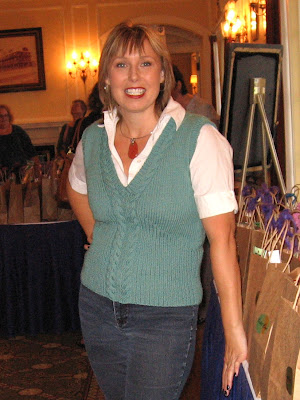The next step for the Design-a-long is to draft the front. I go through the same process as for the back, using my specific numbers that I've developed by working with my personal measurements and those of a target garment or even several garments that I've taken measurements from. I also use the garments as a point of reference when I want to alter things. As an example, I want a full length sleeve and I have two garments with 3/4 sleeves and one with sleeves that are too long. I used that one by putting a pin in the spot that I want my sleeve to end.
I marked in the major measurements on my graph paper, and drew in all my lines. I added a button/neck band of 1 inch. Your bands can be what ever width you like, you just need to account for them on your schematic. They can overlap at center front if you are doing buttons and buttonholes. That means that 1/2 your band width is subtracted from the measurement of each front. You could choose to do bands that meet at center front and close with a single button and loop with no overlap, in that case the total band width gets
subtracted from each front measurement to attain your target number.
I also do a detailed underarm, shoulder and neckline at this point. I print off knitting graph paper from here in my gauge. I draw in my lines in with every square equaling a stitch. The site says the paper is actual size but I often find it is just a little out over longer measurements even when I un-check fit to file as per the instructions on the site. I mark the shoulder line then the vertical line down to the armhole depth measurement and finally the horizontal line is my front 1/2 bust measurement - the cross shoulder measurement divided by two. I then mark the curve off on the graph paper in the way I will actually knit it. I either use a compass or the edge of a round jar to indicate a curved line. You can see it as a dotted line on my schematic My first cast off is 1 inch worth of stitches. Then I mark off decreases at the rate of one every right side row. If it works out that I need more than 3 single decreases. I rejig and do two initial cast offs. To clarify, in my example I need to decrease 15 stitches. I ended up with cast off 6 stitches, cast off five stitches and cast off 1 stitch 3 times.
I always teach people how to do angles and curves visually on graph paper even though it can be done mathematically. I find the majority of knitters are very visual and once you learn to plot on graph paper you can more easily switch to calculating the numbers. I do everything mathematically on a spreadsheet when I grade patterns, however I still revert back to graphing when ever I do work with unfamiliar shapes.
Reality check: as a final confirmation for the armhole, I use either my flexible ruler or a tape measure standing on its side to measure around the armhole drawing. If the knitters graph pattern didn't turn out at a true actual size, I do a real size drawing to take the curved measurement from. I double this number and using a binder clip or a paper clip I use my measuring tape and make a loop of the tape of the correct measurement. I slip this tape up my arm to my shoulder and make sure that the armhole sits in the correct location on my body. I use the bony shoulder protrusion to find that spot. Check to see that the underarm fits you in a way you like. That's an ease decision, the armhole of a garment usually rests one to two inches below your armhole in a fitted classic cardigan like this.
Next time I'll talk about shoulders and necklines.
Links to the other posts:
http://knittingrobin.blogspot.ca/2011/12/knitting-basic-boring-garments-that-we.html
http://knittingrobin.blogspot.ca/2011/12/design-long-tools-and-supplies.html
http://knittingrobin.blogspot.ca/2011/12/design-long-measurements.html
http://knittingrobin.blogspot.ca/2011/12/design-long-taking-measurements.html
http://knittingrobin.blogspot.ca/2012/01/design-long-swatching-yes-you-have-to.html
http://knittingrobin.blogspot.ca/2012/01/design-long-more-details-on-swatching.html
http://knittingrobin.blogspot.ca/2012/01/design-long-paper-pattern-part-1.html
http://knittingrobin.blogspot.ca/2012/01/design-long-paper-pattern-part-2.html
http://knittingrobin.blogspot.ca/2012/02/design-long-paper-pattern-part-3.html
http://knittingrobin.blogspot.ca/2012/02/design-long-paper-pattern-part-4-dart.html
http://knittingrobin.blogspot.ca/2012/02/design-long-paper-pattern-part-5.html
http://knittingrobin.blogspot.ca/2012/02/design-long-paper-pattern-part-6-sleeve.html
http://knittingrobin.blogspot.ca/2012/03/design-long-paper-pattern-part-7.html
Links to the other posts:
http://knittingrobin.blogspot.ca/2011/12/knitting-basic-boring-garments-that-we.html
http://knittingrobin.blogspot.ca/2011/12/design-long-tools-and-supplies.html
http://knittingrobin.blogspot.ca/2011/12/design-long-measurements.html
http://knittingrobin.blogspot.ca/2011/12/design-long-taking-measurements.html
http://knittingrobin.blogspot.ca/2012/01/design-long-swatching-yes-you-have-to.html
http://knittingrobin.blogspot.ca/2012/01/design-long-more-details-on-swatching.html
http://knittingrobin.blogspot.ca/2012/01/design-long-paper-pattern-part-1.html
http://knittingrobin.blogspot.ca/2012/01/design-long-paper-pattern-part-2.html
http://knittingrobin.blogspot.ca/2012/02/design-long-paper-pattern-part-3.html
http://knittingrobin.blogspot.ca/2012/02/design-long-paper-pattern-part-4-dart.html
http://knittingrobin.blogspot.ca/2012/02/design-long-paper-pattern-part-5.html
http://knittingrobin.blogspot.ca/2012/02/design-long-paper-pattern-part-6-sleeve.html
http://knittingrobin.blogspot.ca/2012/03/design-long-paper-pattern-part-7.html





















